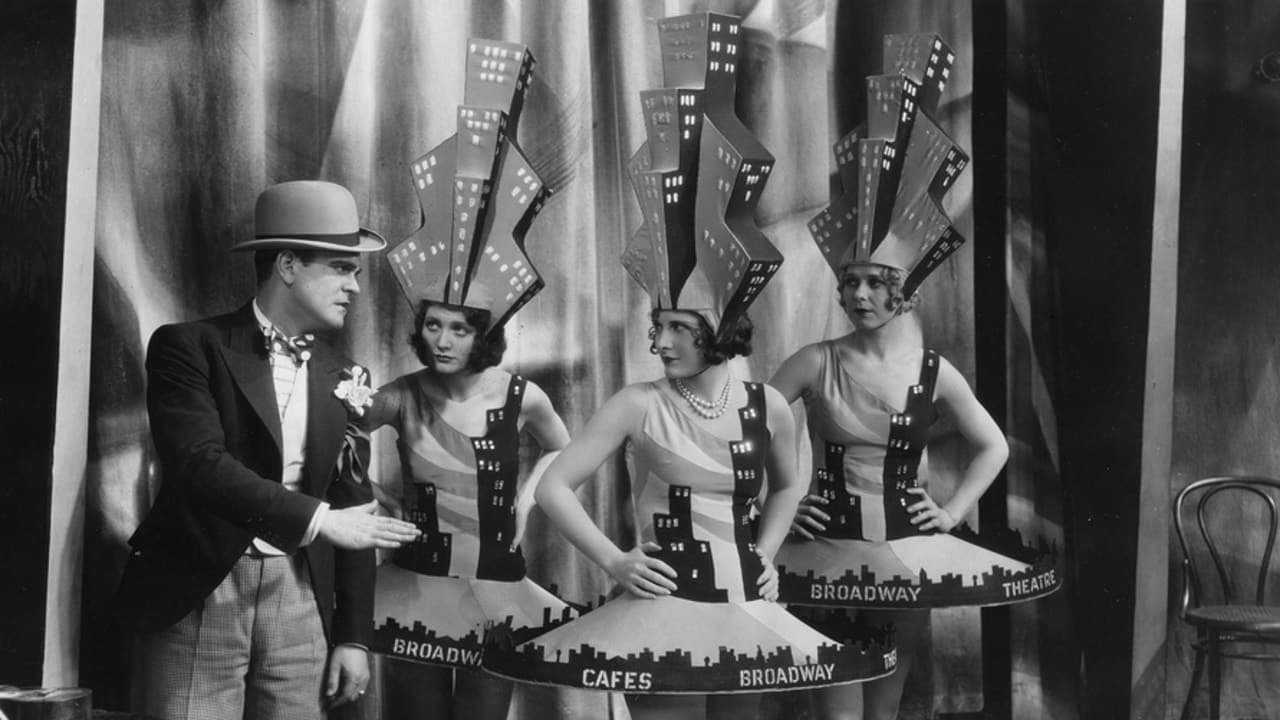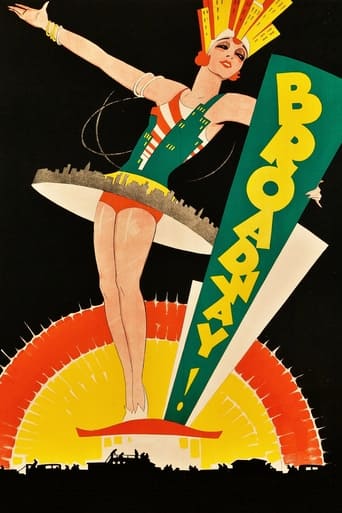

Had to pinch myself to see if I wasn't dreaming - just a mighty opening - Broadway, that monolithic monster chewing up all the hopes and dreams while daring the dreamers to come on in!! It was Universal's big special production of the year and Laemmle Jr. spent over a million to bring Phillip Dunning's and George Abbott's hit drama to the silver screen. Laemmle commissioned a huge Art Deco night club set, 70 feet high and a city block wide which replaced the small, intimate cabaret of the play. Paul Fejo is the real star - he designed a crane to give the camera fluidity of movement and travel from every angle.The musical numbers are secondary to the story and while, with countless imitations, it is as familiar as an old shoe, back in 1929 it was fresh and exciting. Even in 1929 the imitators started in with movies like "Broadway Babies" and "Broadway Hoofer" but as one contemporary commentator said "all they could steal were stones from the mountain, the mountain itself remained"!!Mordaunt Hall may have declared that Lee Tracy was a far better Roy Lane but Glenn Tryon was pretty good and he was comfortable with dialogue. He played Lane, a song and dance man in the Paradise Club who leads the chorus girls through their paces while waiting for a lucky break that is going to propel him and his partner Billie Moore to the big time - or at least "Chambersburg and Pottsville"!! "Hitting the Ceiling" and "Broadway" are the show stopping tunes but the real action takes place behind the scenes. Sweet Billie (Merna Kennedy, fresh from Chaplin's "The Circus") - she does tend to slow the story down a bit with her mushy "you wouldn't kid me would you" and "I'm for you , you know I am"!! She is being romanced by slick bootlegger Steve Crandall. As played by Robert Ellis he seems to have genuine feelings for her, calling her "little fella" and "I'd murder for you" but with his gang he is all business and it is the murder of Scar Edwards (Leslie Fenton), shot in the back that brings about his downfall.Thomas Jackson who repeated his role as the laconic detective Dan McCorn was singled out for high praise. His distinctive, dead pan delivery soon had him typecast as a stone faced law man in films such as "Little Caesar" etc. Evelyn Brent was also given good notices and for me she gave one of the best performances. She was Pearl, a tough chorine who has a good reason for wanting Crandall bought to justice.So different from a lot of the early talkies - actors play and recite their dialogue as though they mean it and the slang and the wisecracks must have enthralled movie goers at the time. "Weisenheimer", "swell fella", "four flusher", "if a Jane I'd pinned all my hopes on was going to Hell" and as one chorus cutie wisecracks when told to put on a happy face for the customers "smile at 'em? - we can hardly keep from laughing at 'em". And in cutting pre-code put down "If I've ever seen a professional virgin, she's it"!!!Highly Recommended!!
... View MoreIf you take away director Paul Fejos's flashy crane shots and stunning opening sequence set to the music of Ferde Grofe's "Metropolis," there isn't much left to "Broadway," an otherwise static transfer of a stage play to the screen in the early talking era. The quality of the sound is superior to most talkies made in 1929 and the camera set ups and actor blocking are slightly less moribund, but there are still too many long sequences of posed bodies mouthing dull dialogue. Glenn Tryon, the appealing vaudevillian from Fejos's "Lonesome" the year before, is fine as the hoofer who dreams of getting out of Club Paradise and hitting it big. And Evelyn Brent, in what amounts to a supporting role, dominates the screen with her smoldering presence whenever she appears. Problem is, in order to make this routine play about backstage intrigue involving showgirls and bootleggers interesting as cinema, Fejos chose to make liberal use of innovative, ambitious crane shots, requiring an inflation of the nightclub setting to such gargantuan proportions that the main character's ambitions seem questionable; isn't he already headlining in the biggest show place on earth outside a football field? Rather than a small-time venue, we get something more like a surrealist-cubist airplane hangar and it soon becomes clear that the movie is simply an excuse for Fejos to experiment with a new toy. The sweeping camera draws attention to itself, whereas the liberal use of superimpositions in "Lonesome" a year earlier revealed truths about modern mechanized drudgery and the nature of urban crowds. Most of the songs by Con Conrad, Sidney D. Mitchell and Archie Gottler are cut off before they can get much beyond their introductions, their purpose reduced to another means of showing off the gigantic stage set. At well over 90 minutes, "Broadway" outstays its welcome. The much-touted finale, synced to a reprise of the film's best song, "Hittin' the Ceiling," looks like a jerkily animated third-generation color photocopy.
... View MoreI know that the talking version without the Technicolor final exist and the silent version with the subtitle exist.I had assumed one day a copy of talking version would be edited to the final,form the silent version, with substitute sound affects,to make a complete print ,wrong!What the company did is that they took the silent version, shorten and edited it, to sound only with the sound version track only.This was stupid .Now the incomplete talking version is still not available.The company obviously could not afford it or may be their was a copy right problem with the incomplete film .It sounded and looked stupid.But it was better than nothing.Evelyn Brent plays a hard boil chorus girl.Glenn Tyrone an ambitious dancer who want to team with Myrna Kennedy.But she is going out with a mobster,played by Thomas E Jack son,I think,who just killed a bootlegger.In spite of the attempt's to syn the sound with silent, the story was clear..The color ending is faded and could be restored through recreating the color through creating separation from the main print on a computer.It's probably too expensive too.04/14/12. Criterion has just released the restored talking version of Broadway,Part of Pal Fejos collection,Lonesome.It is the talking print.Although the ending is lost it uses the silent version as a substitute with the beginning of the sound track of the sound track of the talking version.This print makes more sense and it's excellent too.09/21/12
... View MoreAfter 75 years considered lost, "Broadway" directed by Herr Paul Fejos was found in Hungary, in a very well preserved copy with Hungarian titles but that European language is not a problem for this German Count because he remembers very well those Austro-Hungarian old times. This remarkable discovery gives silent fans the chance to watch the virtuosity of camera work of a director not very well known. His obscurity is a complete disgrace because Herr Fejos'surviving silents are absolutely fascinating."Broadway" tells the story of underworld criminals who run the "Paradise Club". In between musical numbers we have crimes and intrigues involving showgirls and special investigators. Passion, strange business and love affairs are all part of the mix too."Broadway" shows characters caught up in dual roles and the turmoil in which feelings come out into the open, the sort of conflicts that Herr Fejos was so fond of.The most remarkable aspect of this film is the extraordinary camera work, especially Herr Fejos' use of an enormous and amazing camera crane which he himself designed and which scrutinizes every corner of the "Paradise Club", giving a frenzied rhythm to the film with those incredible camera movements. It also highlights with many details and angles, the beautiful and astounding sets that are the backgrounds for the fuss, happy and dangerous night life in the Broadway streets. The second notable aspect of this modern silent film is that it was made before the superb "Lonesome" (1929) and, like that film, it is part of the transition period between silent films and talkies. "Broadway" was an early musical available in both formats, silent and talkie and what's more, the silent version found in Hungary is a complete copy that includes at the end of the film "Technicolor" footage ( faded after so many years ) of the final musical scene number and this so startled this German Count that his monocle popped out from his aristocratic eyes more than once.And now, if you'll allow me, I must temporarily take my leave because this German Count must leave vaudeville behind and attend the opera.Herr Graf Ferdinand Von Galitzien http://ferdinandvongalitzien.blogspot.com/
... View More